Comics
Flash Gordon
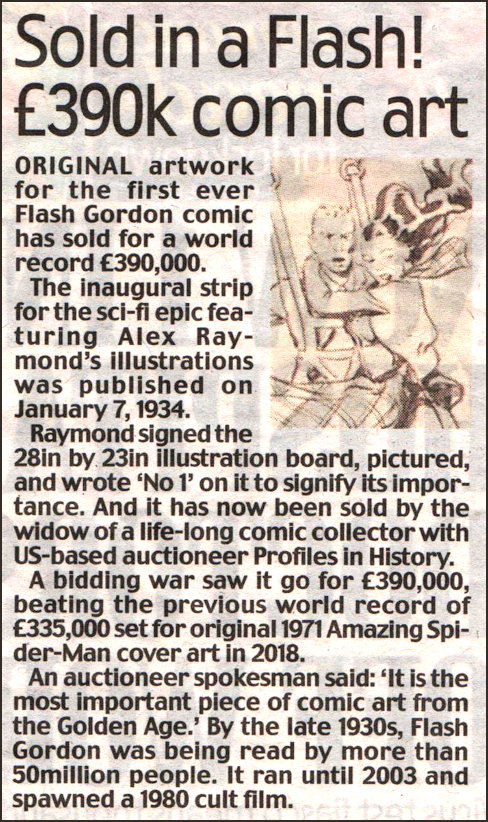
A hero is born: Original artwork from the first ever Flash Gordon comic published in 1934 is listed for sale at £465,000 by life-long collector
- The inaugural strip, published in 1934, will go on sale on March 31 for £465,000
- Cartoonist Alex Raymond signed the illustration board to signify its importance
- Pencil and ink artwork is being sold by the widow of a life-long comic collector
- Auctioneer said it is 'most important' Golden Age artwork to go under hammer
By Katie Weston For Mailonline |Published: 11th March 2020 | Updated: 11th March 2020
The original artwork from the first ever Flash Gordon comic, featuring a signature and 'No 1' written by the cartoonist Alex Raymond, has been listed for sale by a life-long collector at £465,000. The inaugural strip for the sci-fi epic featuring Raymond's illustrations was published on January 7, 1934. Raymond signed the 28 by 23 inch illustration board and wrote 'No 1' on it to signify its importance. Almost 90 years later the pencil and ink artwork is being sold by the widow of a life-long comic collector with US based auctioneer Profiles in History. They describe it as the 'most important' piece of artwork from the Golden Age to go under the hammer.
The first Flash strip introduced Flash Gordon, a handsome Yale graduate and polo player, and his companion Dale Arden. They parachuted out of a crashing plane and were rescued by Dr Hans Zarkov aboard his rocket ship. This had been launched to intercept the comet Mongo which was hurtling towards Earth. By the late 1930s, Flash Gordon was published in 130 newspapers worldwide and read by over 50million people. It ran until 2003 and has spawned numerous films, as well as inspiring Star Trek and Star Wars.
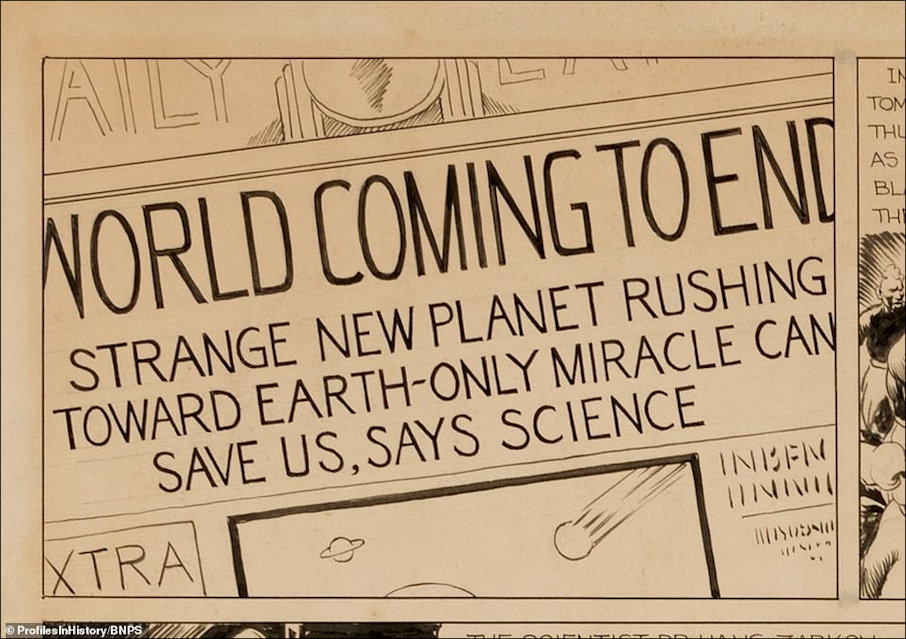
This first edition of 'Flash Gordon' announces himself by declaring the 'World is coming to an end!' - image sourced from ProfilesInHistory/BNPS (Bournemouth News & Picture Service) via MailonLine
A Profiles in History spokesperson said: 'The historical impact Flash Gordon had on science fiction and pop culture heroes of the 20th century cannot be overstated. 'The 'space western', emphasising space exploration as the final frontier, influenced Gene Roddenberry to create Star Trek. 'George Lucas had originally wanted to adapt the Flash Gordon serials in the 1970s, yet was unable to secure the rights, and his project evolved into Star Wars. 'This extraordinary offering represents a once-in-a-lifetime opportunity to obtain the artwork serving as the genesis of history's greatest science fiction hero. 'It is the most important piece of comic art from the Golden Age.'
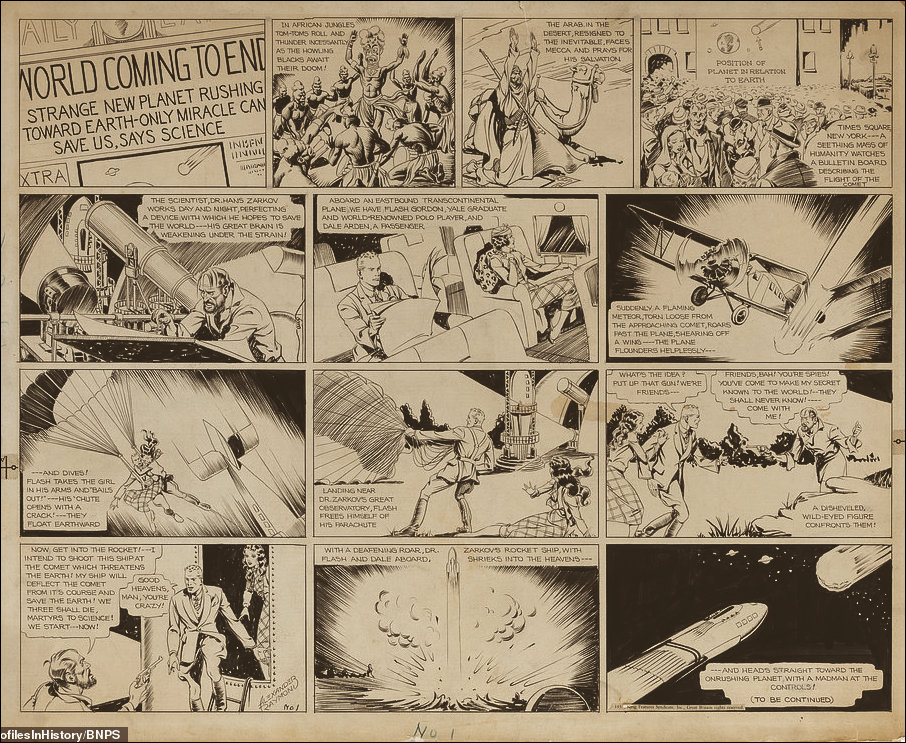
The original artwork from the first ever Flash Gordon comic published in 1934 - "The full comic strip can be seen here, which depicts Flash Gordon on his way to save the planet from an in-coming rogue planet that is on a collision course with Earth. 'No 1' can be seen written on the side by artist Alex Raymond showing its significance" - image sourced from ProfilesInHistory/BNPS (Bournemouth News & Picture Service) via MailonLine
US publishing company King Features Syndicate assigned Raymond to create a Sunday page to compete against the popular Buck Rogers strip that made its newspaper debut in 1929. Flash Gordon quickly developed an audience far surpassing Buck Rogers, due to Raymond's artwork and ghostwriter Don Moore's engaging storylines. In 1980, the cult film Flash Gordon was released, starring Sam Jones, Melody Anderson, Timothy Dalton and Brian Blessed. Its soundtrack was famously written and performed by the rock band Queen.
The sale took place on 31st March 2020 | Original artwork from first ever Flash Gordon comic published in 1934 is listed for sale at £465,000
Original artwork of the first ever Flash Gordon comic has sold for a world record $480,000 - 90 YEARS after it was first drawn
- The sale breaks the previous record of £335,000 for when the 1971 Amazing Spiderman cover art sold in 2018
- This original artwork was first drawn by Alex Raymond on January 7, 1934. Flash Gordon ran until 2003
- It led to a hit-1980s film by the same name, and was the inspiration behind much of the 20th century's Si-Fi
- Star Wars creator George Lucas wanted to adapt the comic in the 70s, but couldn't secure the rights
By Chris Jewers For Mailonline and BNPS | Published: 1st April 2020 | Updated: 2nd April 2020
Original artwork for the historic first ever Flash Gordon comic has sold for a world record price of $480,000 (£390,000). The inaugural strip for the sci-fi epic featuring Alex Raymond's illustrations was published on January 7, 1934. Raymond signed the 28ins by 23ins illustration board and wrote 'No 1' on it to signify its importance. Almost 90 years later the pencil and ink artwork was sold by the widow of a life-long comic collector with US-based auctioneer Profiles in History. They described it as the 'most important' piece of artwork from the Golden Age to go under the hammer.
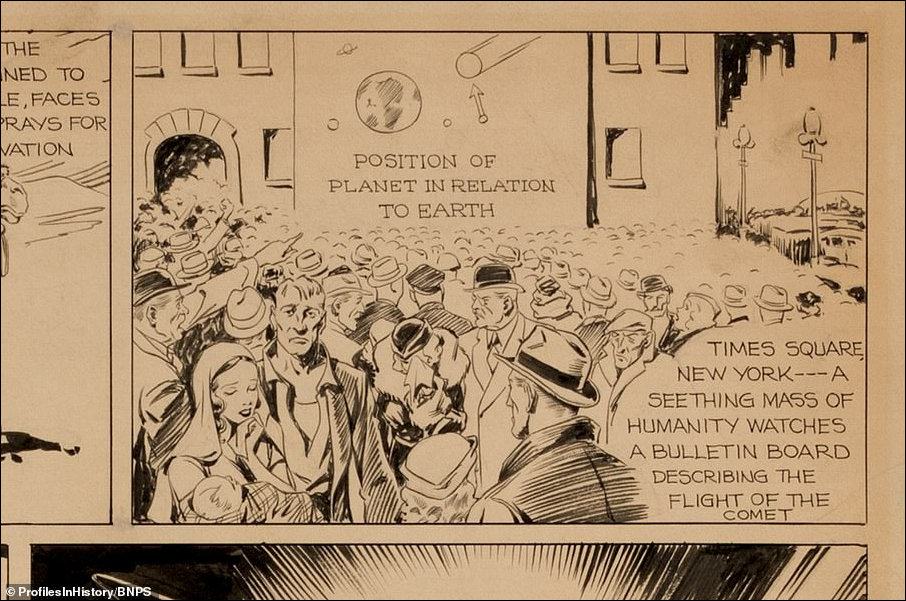
Position of Planet (Mongo) in relation to Earth (no sign of 'Ming the Merciless' yet - image sourced from ProfilesInHistory/BNPS (Bournemouth News & Picture Service) via MailonLine
It sparked a bidding war, beating the previous world record of (£415,000) £335,000 set for original 1971 Amazing Spiderman cover art in February 2018. A Profiles in History spokesperson said: 'This extraordinary offering represented a once-in-a-lifetime opportunity to obtain the artwork serving as the genesis of history's greatest science fiction hero. 'It is the most important piece of comic art from the Golden Age, achieving a world record for comic strip art.' The first Flash strip introduced Flash Gordon, a handsome graduate and polo player, and his companion Dale Arden. They parachuted out of a crashing plane and were rescued by Dr Hans Zarkov aboard his rocket ship. This had been launched to intercept the planet Mongo which was hurtling towards Earth.
By the late 1930s, Flash Gordon was published in 130 newspapers worldwide and read by over 50 million people. It ran until 2003 and has spawned numerous films, as well as inspiring Star Trek and Star Wars. The spokesperson added: 'The historical impact Flash Gordon had on science fiction and pop culture heroes of the 20th century cannot be overstated. 'The 'space western', emphasising space exploration as the final frontier, influenced Gene Roddenberry to create Star Trek. 'Also, George Lucas had originally wanted to adapt the Flash Gordon serials in the 1970s, yet was unable to secure the rights. His project evolved into Star Wars.'
US publishing company King Features Syndicate assigned Raymond to create a Sunday page to compete against the popular Buck Rogers strip that made its newspaper debut in 1929. Flash Gordon quickly developed an audience far surpassing Buck Rogers, due to Raymond's artwork and ghostwriter Don Moore's engaging storylines. In 1980, the cult film Flash Gordon was released, starring Sam Jones, Melody Anderson, Timothy Dalton and Brian Blessed. Its soundtrack was famously written and performed by the rock band Queen.
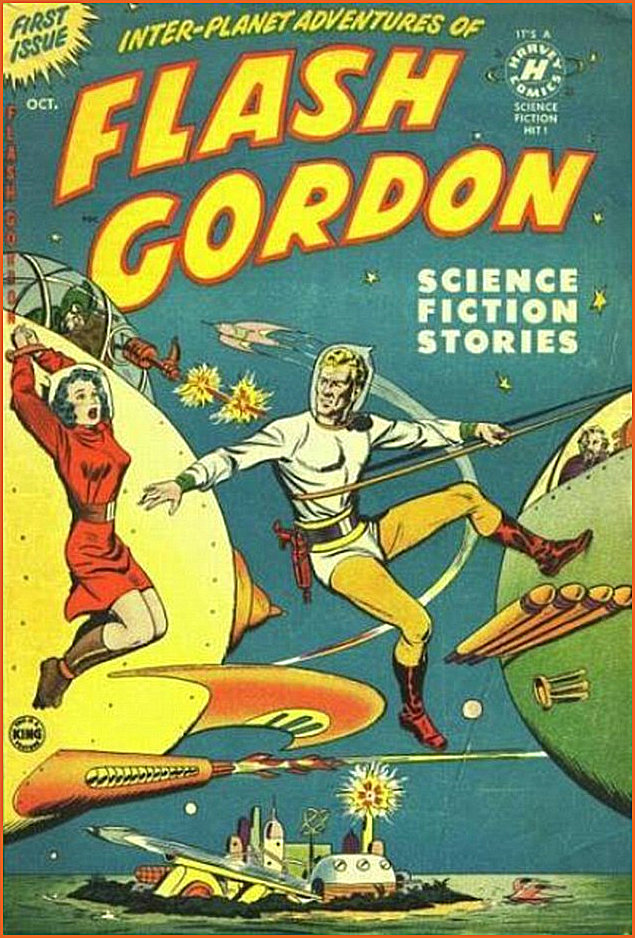
Flash was invented as a comic in 1934 by artist Alex Raymond - image sourced from Mail Online
1960
'Judy' featuring 'Sandra of the secret ballet' and 'Star of the Wrens'

Issue no. 41 of Judy which had launched in January 1960, I like all the ballerina references and the kittens (Sandy, Blackie & Snowy) lapping up cream-coloured paint (not advisable in real life!) - a very 'girlie' and empathic cover - image sourced from and courtesy of comiconlinefree.com
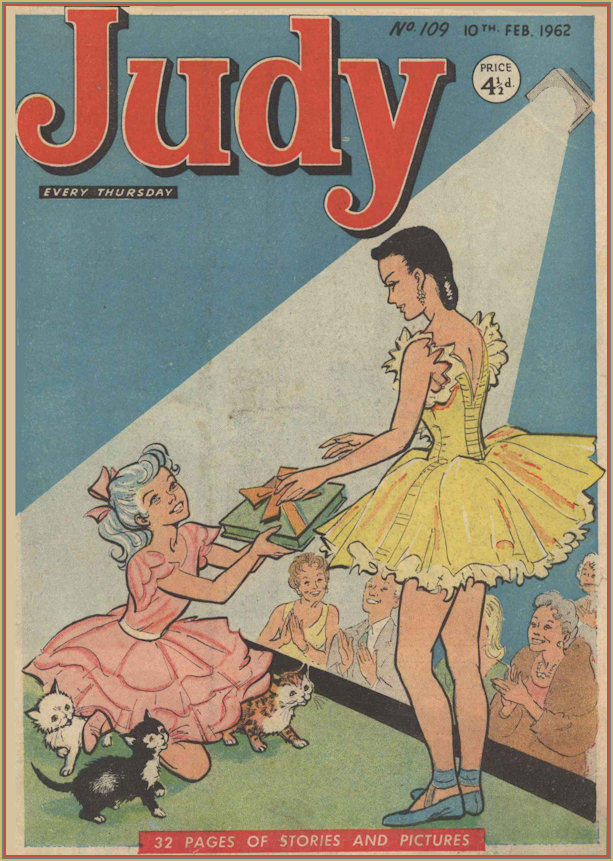
By issue 109 the ballerina takes on greater importance (and size) but Judy, her ponytail and the kittens are still close to centre stage - image sourced from and courtesy of comiconlinefree.com
Somewhere between issues #245 and #316 the empathic 'Judy' with her pony tail and the three kittens vanishes from the covers which then take on a feature story/serial in colour to whet the appetite.

Whilst researching information on the Carreras Black Cat Factory I found a front page containing a myriad of illustrated/pictorial images in the 24th May, 1931 issue of the Sunday Mirror and the famous (unnamed) Argentine dancer caught my eye - would a diet of this sort of artwork have inspired the generation that followed to produce the type of idealistic yet realistic art of the cartoon stories I loved so much as a child? Judge for yourselves** - image sourced from the British Newspaper Archive with thanks
Sandra of the secret ballet School
I loved this story, Sandra, unhappy in her real home life lives through her ballet until she is whisked away from it all to the 'Secret Ballet School' on a remote island ...... (wonder if JKR got her idea for Harry Potter here). At the school (who has some dissenters but not Sandra) she becomes Madame's star pupil (leading to some jealousy along the way of course) and is, despite all the hard work, deliriously happy. The school is set up to appeal to every young girls dream, the unusual uniform, the secrecy, the isolation the total lack of responsibility. Needless to say this is shattered by the sudden disappearance of Madame which leads to the conclusion of the storyline in Spain and some mysterious ritual dance which Madame is unable to complete and Sandra steps in ....
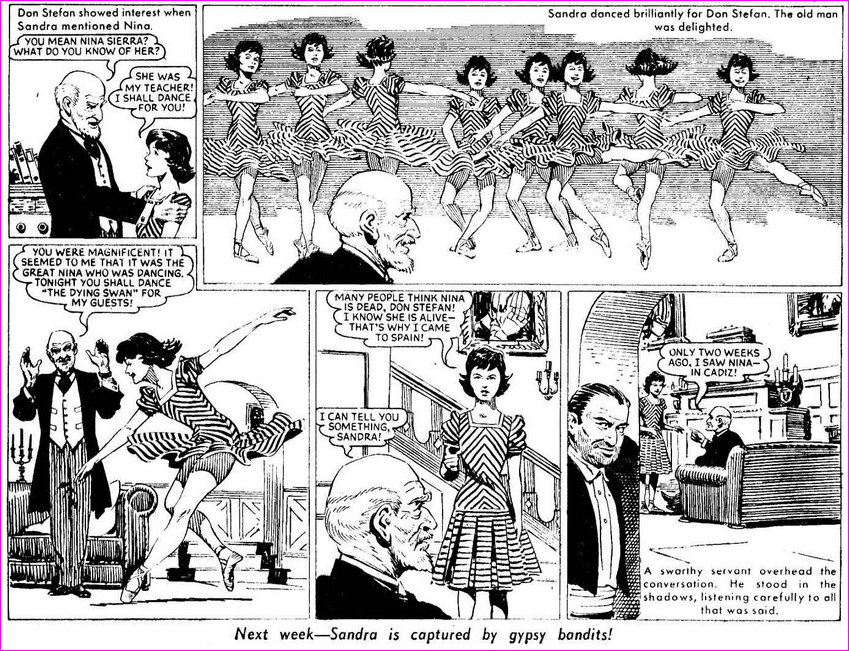
I always loved the artwork and this is an excellent example culminating in the pose I always thought was perfect ballet as Sandra concludes her performance for Don Stefan.
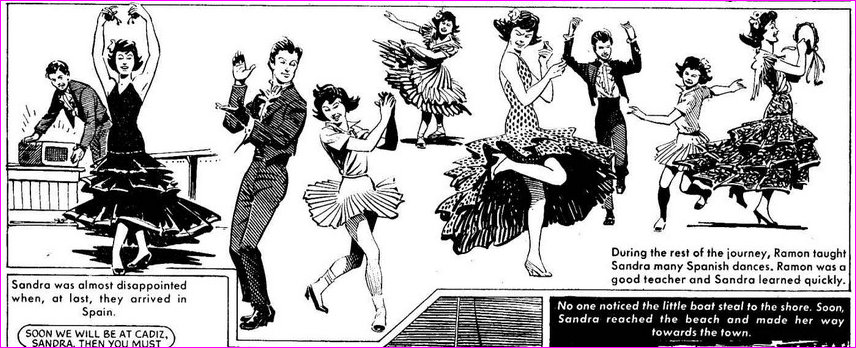
In this particular sequence the story moved away from pur classical ballet and shows Sandra in a variety of Spanish dance poses - quite where she got the costumes (apart from her school uniform of pleated skirt, short-sleeved blouse and bolero) isn't explained (or not as far as I remember anyway!

The synchronised ballet poses used to send me into parodies of ecstasy and I loved the leotard and tights which were not the uniform I had to wear when I attended ballet classes at the YWCA for a year - that was a very short tabard and bare legs (yuk!) - images sourced from : girlscomicsofyesterday.com
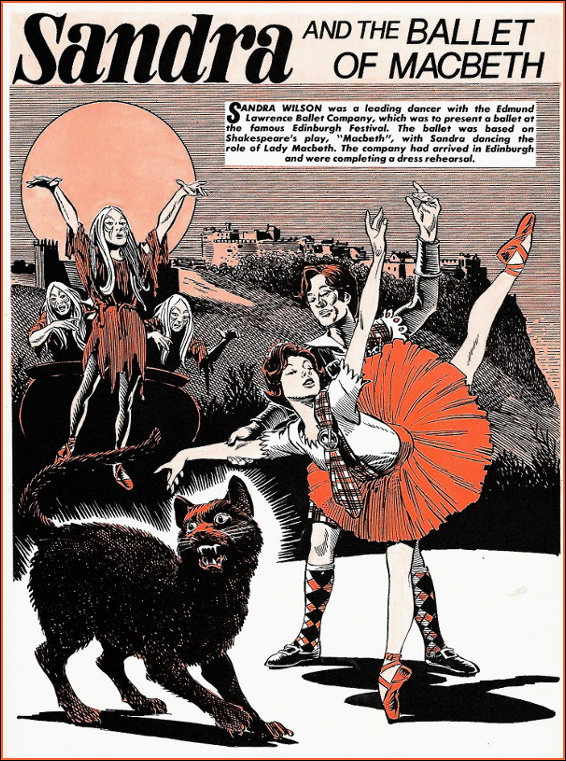
By 1974 I had moved to London and had long left Judy and her ponytail and kittens behind so I never realised how things had changed and what a departure this was from the student Sandra in her secret Ballet School to leading dancer, the infamous Lady McB in 'The Scottish Play' ballet adaptation - how fanciful and severe is the artwork! No cute kittens and the witches look like the 'greys' (aliens) with wigs on - "Sandra and the Ballet of Macbeth Artwork: Paddy Brennan" - image and details sourced from : girlscomicsofyesterday.com
The Silent Three
Mysterious goings on in a boarding school (how I loved boarding school stories, still do!), dressing up in specific secret robes and eye masks (to die for!) - yes it was the stuff of dreams. The Silent Three appeared in franchised comics which I could not always buy and (happily for me) little pocket books either in narrative form or in pictures - I remember owning a couple of them and reading them to death in preference to the stack of other subjects. I think I had a crush of Joan (the one with the pretty bow in her hair) she always looked so perfect. Even after moving on to more adult reading, I retained my love of School stories (mostly, it has to be said, set in boarding schools)
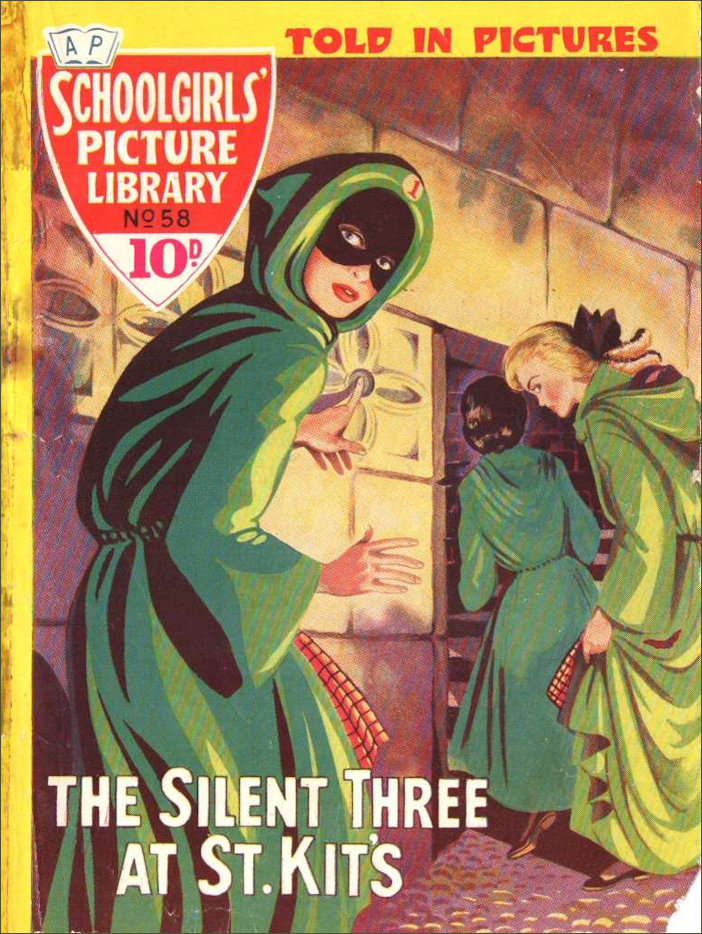
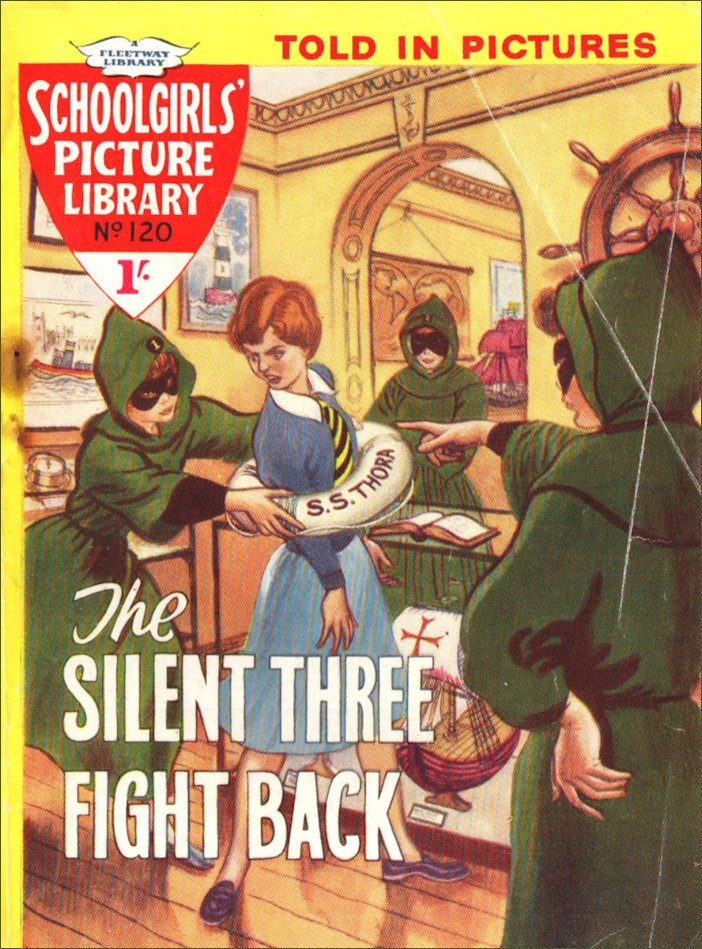
Both of these volumes are 'told in pictures' but look at the difference in price from ten pennies to a whole shilling! I actually remember having both of these although I have seen an updated version of 'Fight Back' (on the internet) which has appalling artwork. With thanks to : comicbookplus for the 'St. Kits' image and comicvine1 for the 'Fight Back' image
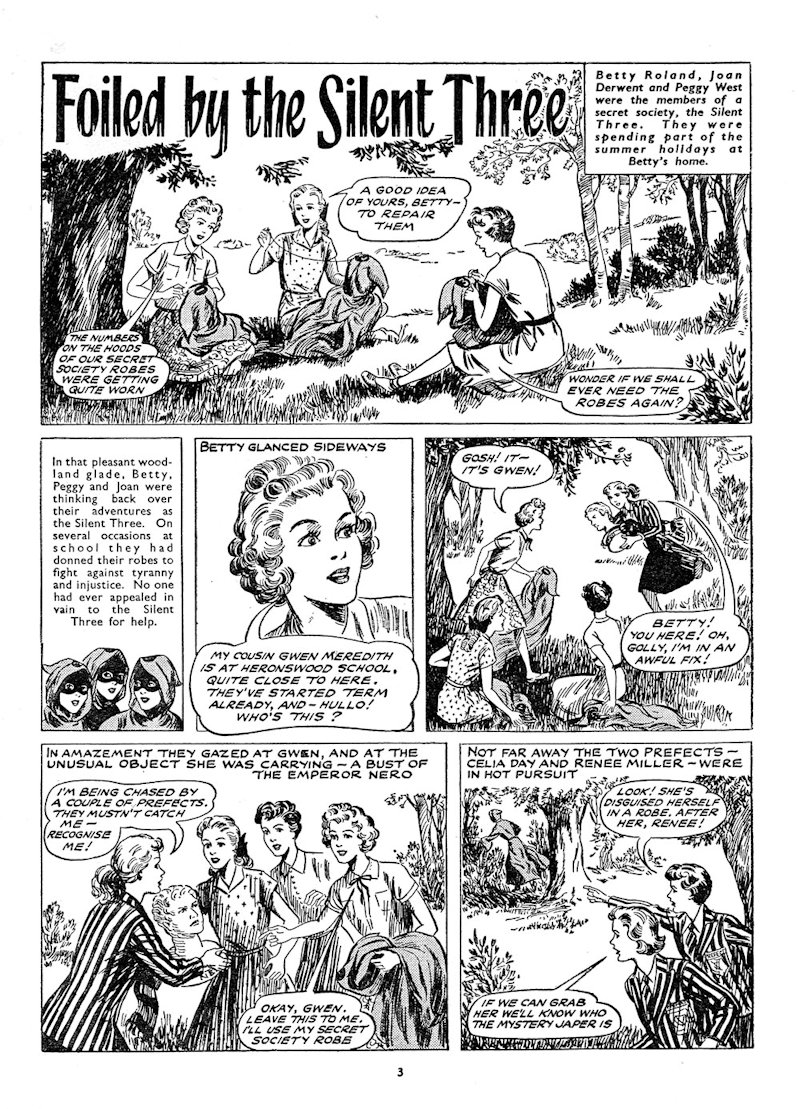
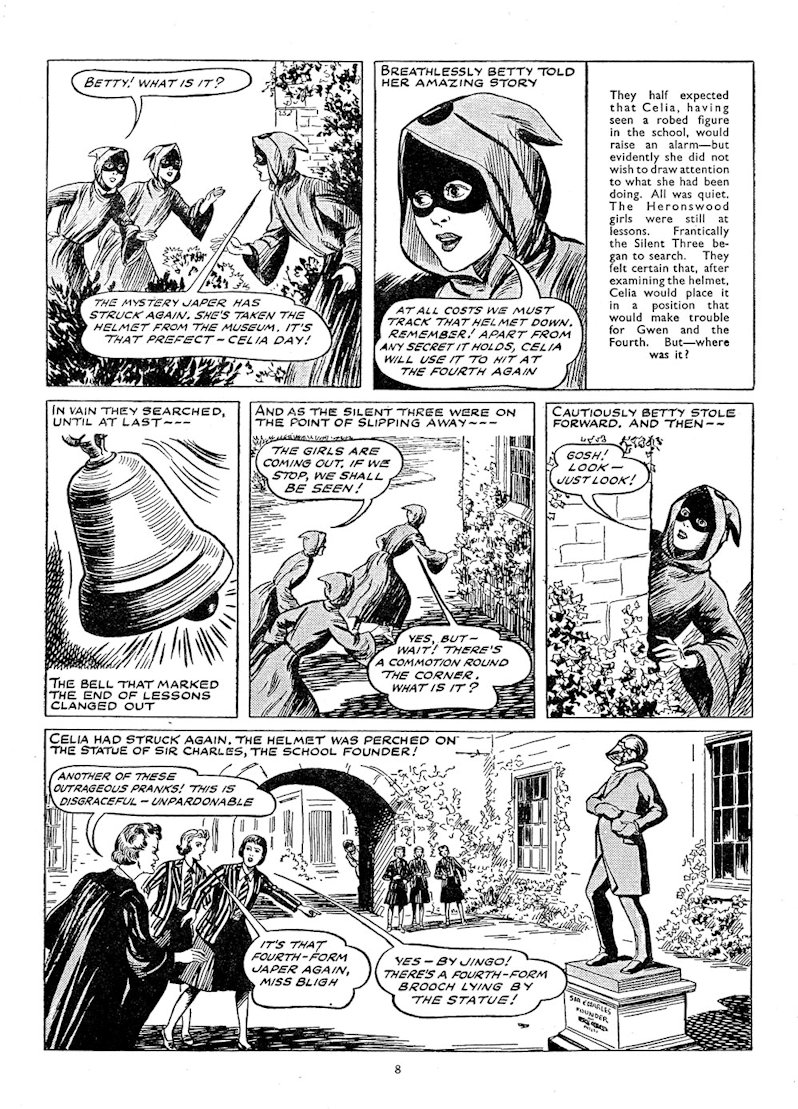

All three Comic pages above sourced from : airforceamazons with thanks
I have used these three pages to illustrate the use of imagery - page 3 illustrates the girls in their customary school uniform getting on with every day pursuits in a happy chummy way. Page 8 has the girls in full action and full robe and mask disguises. Page 9 depicts their problem solving prowess and use of full and partial disguise - these drawings are a feast for the eyes.
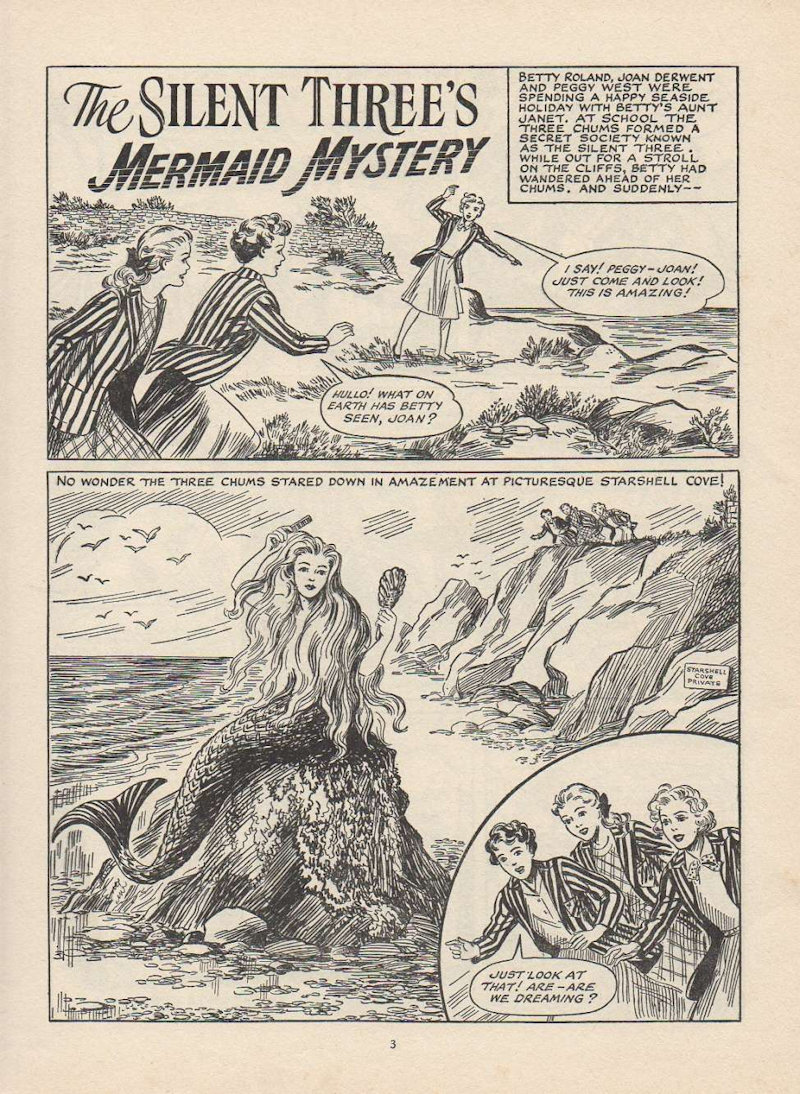
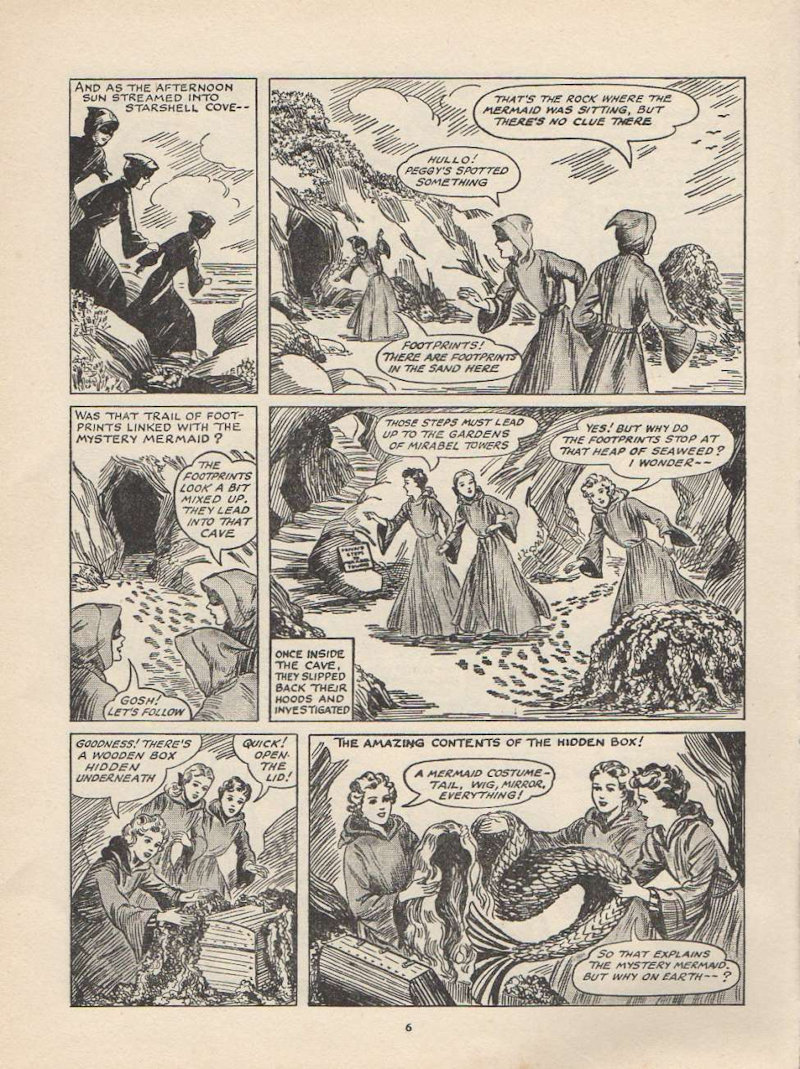
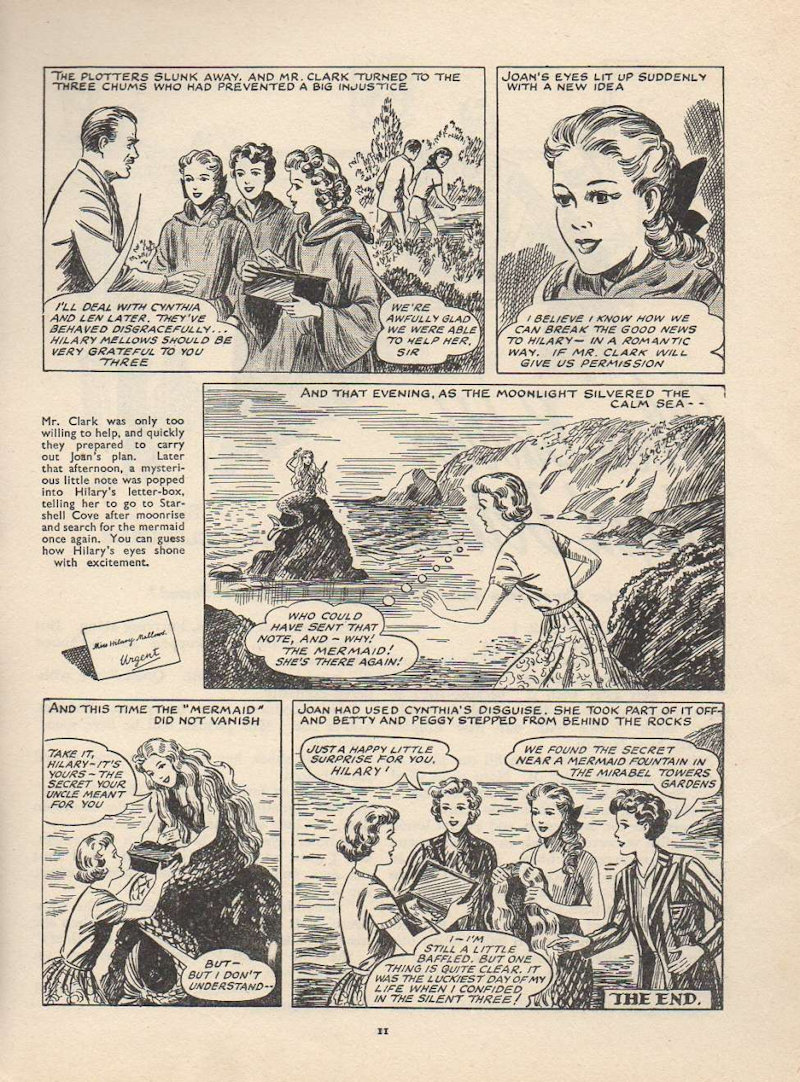
As this story is quite new to me (I'd have remembered Mermaids!) I thought I's include it to show the range of artwork in a fun story which as usual overcomes evil intent - Hurrah for the Silent Three! Images sourced from comicbookplus with thanks
A 'Silent Three' Game (what a bonus!)
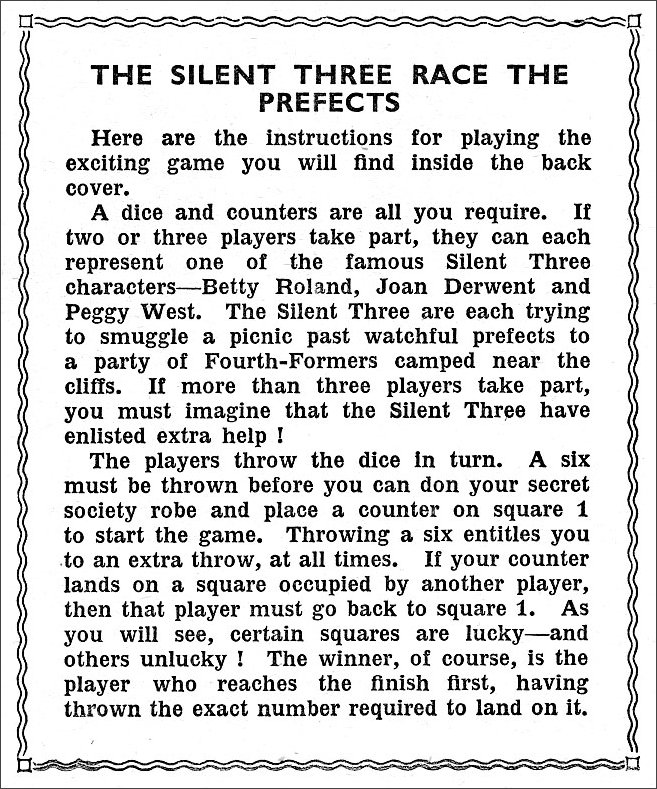
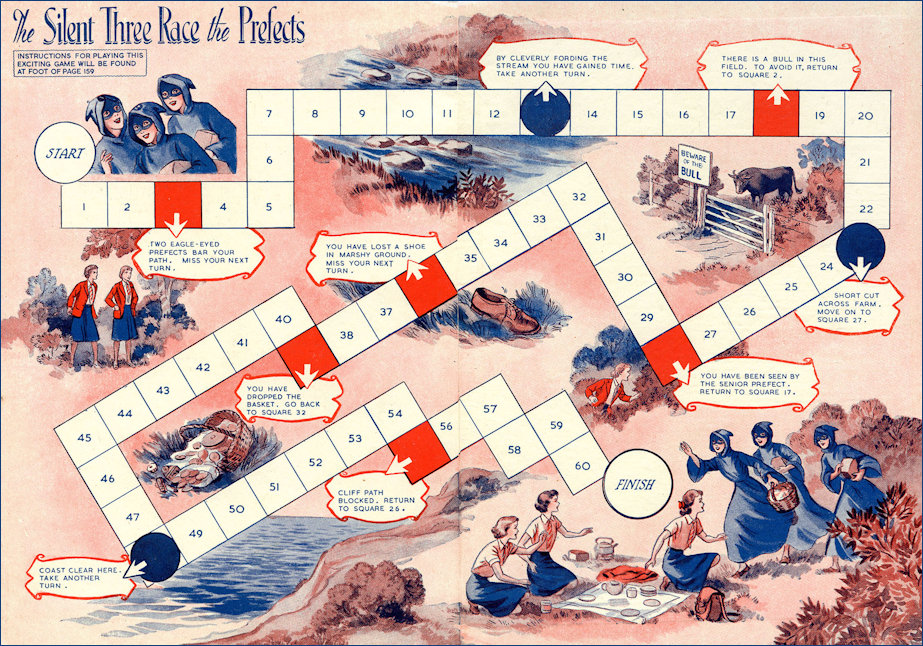
Well I certainly didn't know about this or it would have been kept and cherished somewhere amongst my various cuttings and paper ephemera (and I've got loads of it! Everywhere!) - Many thanks to sadiethepilot for sharing.
Page refreshed : 2nd September 2020 (G)